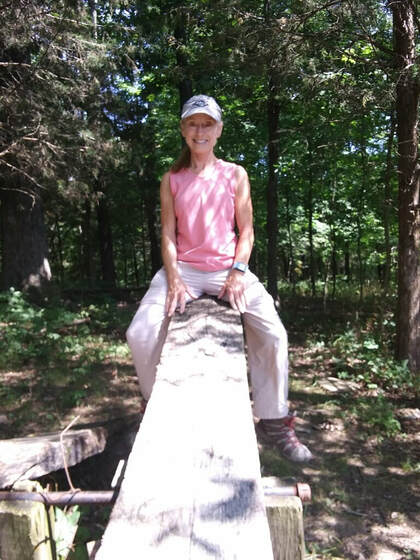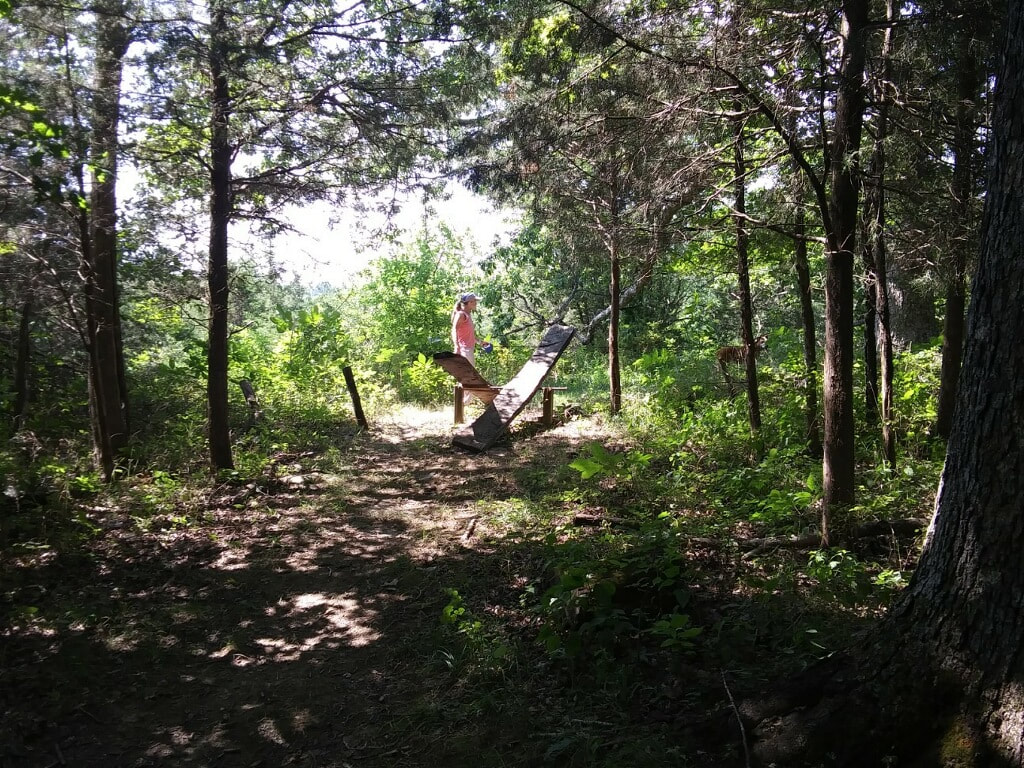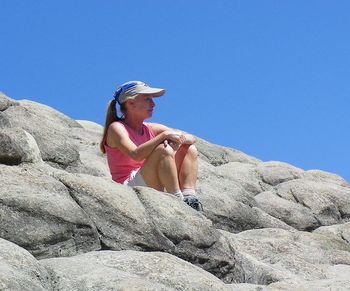 At the summit of the Teeter-Totter Trail. Photos by Rick Showalter. At the summit of the Teeter-Totter Trail. Photos by Rick Showalter. Last Sunday, on yet another unusually cool morning, we decided to take Lucy for a walk at a nearby network of mountain bike trails appropriately called Skullbuster. Rather than staying on the abandoned roadbed as we typically do, we donned hiking pants in a vain effort to ward off ticks and chiggers and headed for the orange trail, a byzantine loop of crisscrossing singletrack that features behemoth oak and maple trees as well as the old Stockdell family cemetery. At one crossroads we decided to check out the Teeter-Totter Trail. I initially imagined the name referred to an undulating path with sharp up and downhill sections. Instead, it turned out to be a gradual uphill through both pastoral woodland and some slightly more open brushy areas. At one point we passed an old stone wall, evidence of a former homestead, which currently serves neither as property line nor rudimentary enclosure. A few yards farther up, at the highest point on the trail, we arrived at a small clearing where a simple bench had been erected among the towering trees. A few steps beyond the clearing were…two teeter-totters. I had not expected that the trail would lead me—literally—to teeter-totters or, as I always called them, seesaws. It was a moment of pure surprise and delight. They appeared rough-hewn but sturdy enough for two adults, so Rick and I tried them out. Lucy was quickly bored, so we took the intersecting path to Wyatt’s World, a trail full of laid stone ramps and log jumps to challenge the cyclists, and eventually found ourselves back on a familiar stretch of the orange trail. As we walked, I thought about how those teeter-totters had gotten there. Remembering the stone wall, I imagined a family in the early twentieth century constructing them to entertain a passel of children. That idea had evidently settled in my mind when Rick mentioned that just as Wyatt’s World was likely named after a central Kentucky cyclist with a penchant for treacherous downhills, he suspected a cyclist named Teeter had been inspired to construct the teeter-totters from leftover lumber as he worked with other volunteers to develop the trail system. His comment startled me. We had both stumbled upon the teeter-totters for the first time just moments earlier and, in that brief period, we had both quietly come to radically different conclusions about how they got there. My romantic mythology arose from my limited understanding of the history of the place, which I had concocted purely from the scant evidence left behind by long ago inhabitants. In my silent musings, those who built the trail system had happened upon a relic of another world. Seeing the same evidence, Rick concluded quite sensibly that those constructing the trail simply hadn’t wanted to lug unused lumber back down the trail and had had imagination sufficient to figure out an entertaining application for it. If a conversation hadn’t ensued, we would have left the trail carrying two immensely different interpretations of this site of human activity. I look to my friends with backgrounds in archaeology or anthropology to explain the human frailty this experience reveals. I will admit it has humbled me. Although I was still embellishing my romantic vision of farm children running toward the teeter-totters after a day of chores, I can imagine how quickly that initial vision might have congealed into “fact.” Can my experience, my understanding of what I observe, my conclusions be so errant from what may actually be true? How quickly I could have gotten to certainty—and been dead wrong. At that moment I realized how easy it is to create our own mythologies. And once we have created them, we are emotionally bound to them. We will not give them up easily. After listening to Rick’s unexpected interpretation of what we saw, I felt fairly quickly that his scenario was probably more likely than mine. But if my vision had had more time to gel, I might have been more stubborn. He might not have been able to change my mind, and I might have fought tooth and nail to defend the mythology I had created. I could imagine myself insisting on the validity of a baseless story I had simply told myself over and over. Perhaps this experience not only provided a much needed dose of humility. Perhaps it also provided a window into the empathy I currently lack to understand those who seem to have fallen under the spell of what I believe to be false interpretations of facts or experiences. I may never share their beliefs, but perhaps, if I were willing to set aside my own contrariness, I can better understand how they came under the sway of a mythology they so dearly want to believe.
6 Comments
Rogers Barde
8/9/2021 08:40:26 am
Very thought provoking and gives me some insight into how our ideas are formed and solidified. I've had that experience in a small way in interpreting the house I am moving into. I thought it had always been built to include an apartment upstairs, and recently had architectural details pointed out to me that proved without a doubt that I was wrong and the rental details were added later. It has changed all my ideas about the house. It is fascinating to have ideas that seem so plausible and real and then find they are wrong. Maybe openness to ideas is the quality I am working on, and aspire to.
Reply
Joseph Anthony
8/9/2021 03:03:07 pm
A wonderful book is "Motel of the Mysteries" where way distant archeologists come up with wonderful theories about a motel ruin of the 20th century . They theorize as to the great altar (the tv) the sacred urn (the toilet) and many other artifacts. David Macaulay teases us out of certainty. I try to leave room for "I'm probably wrong" because I am wrong so frequently.
Reply
Sallie Showalter
8/9/2021 11:39:46 pm
Oh, that does indeed sound like a "must-read"!
Reply
David Hoefer
8/9/2021 09:42:52 pm
Ah, those name variations again…seesaw or teeter-totter. (I'm a seesaw man myself.) As for the rest, you and Rick were, I think, simply hypothesis-building. Both explanations are at least plausible in the absence of contradictory information (though both can't be equally right). Something else to keep in mind is that moderns mistakenly use myth to mean falsehood. Myths often relay deeper truths, albeit indirectly and with some surface misdirection. The pleasure of discovering an unexpected playground hidden in the remote woods tells us something about positive our humanity.
Reply
Sallie Showalter
8/9/2021 11:37:29 pm
Thank you, David! I was hoping you would weigh in.
Reply
Bob Patrick
8/12/2021 07:42:46 pm
Those are pretty thick planks, so probably not intended for teeter-totters originally. They are resting on iron pipe and there's a cap on at least one end. That pipe didn't get there by change, maybe intended as part of a system to draw water from a stream or sping, Some one took the trouble to bury some pretty substantial supports and to do two teeter-totters, not just one. So maybe there were more kids (peo[ple) around than just tow. Very puzzling.
Reply
Your comment will be posted after it is approved.
Leave a Reply. |
Details
Archives
June 2023
Categories
All
|



 RSS Feed
RSS Feed